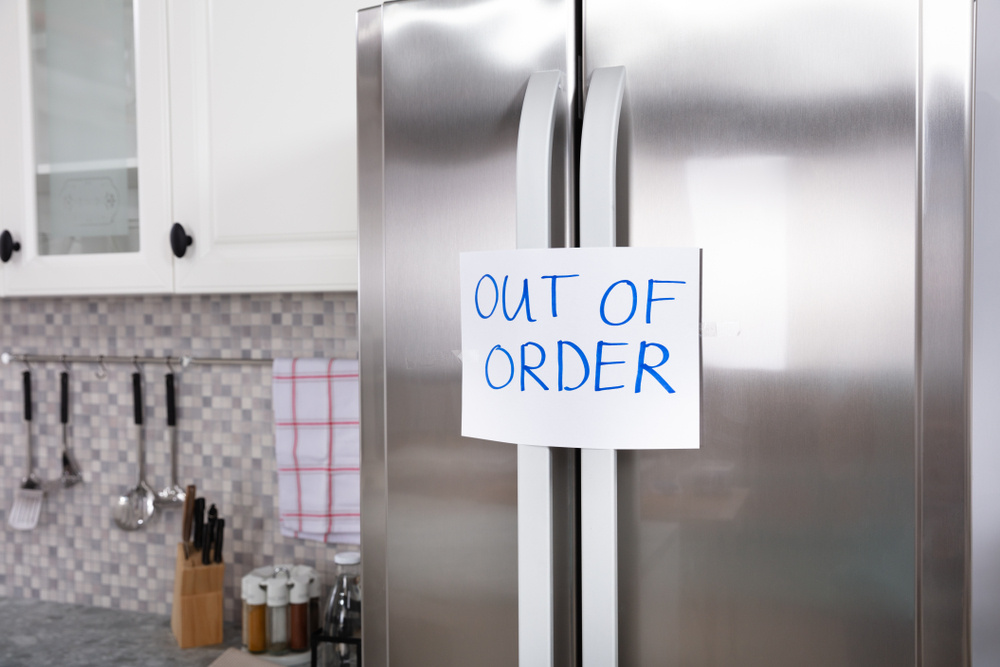Your refrigerator suddenly stops working, threatening hundreds of dollars worth of groceries. Before panic sets in, know that many refrigerator problems have simple solutions. This comprehensive guide will walk you through diagnosis, troubleshooting, and prevention of common refrigerator issues.
Sign up for our Blog!
Common Causes of Refrigerator Power Issues
1. Power Supply Problems
Power-related issues are usually the simplest to fix and should always be your first checkpoint. Think of your refrigerator like a chain - electricity needs to flow smoothly through each link to work properly. Before you worry about expensive repairs, let's check each part of this power chain:
- Electrical Outlet Performance: Just like testing a flashlight with new batteries, plug another working appliance (like a phone charger or lamp) into the same outlet. If the test appliance doesn't work, you've found your problem! This means the outlet isn't delivering power to your fridge.
- Circuit Breaker Status: Your home's electrical panel (that gray box usually in the garage or basement) has switches called circuit breakers. These breakers act like safety valves - they "trip" or switch off when too much electricity flows through them, protecting your home from electrical problems. Find the switch labeled for your kitchen or refrigerator. If it's in a different position than the others or feels loose, flip it all the way off and then back on.
- Power Cord Condition: Your fridge's power cord is like a garden hose for electricity. Just as a cracked hose leaks water, a damaged power cord can't properly deliver electricity. Look closely at the entire length of the cord. Check for:
- Black scorch marks
- Cracked or peeling rubber coating
- Bent or damaged metal prongs
- Places where pets might have chewed
- Kinks or pinches in the cord
Professional refrigerator repair costs typically range from $200 to $400, but checking these power basics first might save you that expense. Often, the solution is as simple as:
- Plugging your fridge into a different outlet ($0 cost)
- Resetting a tripped circuit breaker ($0 cost)
- Replacing a damaged power cord ($20-40 if you do it yourself)
2. Electronic Control Board Malfunctions
The electronic control board is like your refrigerator's brain. Imagine it as a smart traffic controller, telling different parts when to turn on and off. This computer board manages everything from temperature control to the ice maker. When this "brain" starts having problems, you'll notice several signs:
- Complete power loss: The whole refrigerator goes dark and silent, like turning off a computer
- Dark interior lights: The lights inside don't turn on when you open the door, even though you know the bulbs are good
- Erratic temperature fluctuations: The fridge can't decide if it should be cold or colder, like a thermostat that can't make up its mind
- Unusual operational patterns: Your refrigerator might:
- Start and stop more frequently than normal
- Make new or strange humming sounds
- Have some parts working while others don't (like the freezer works but the fridge doesn't)
- Show error codes or blinking lights on the display panel
These symptoms often appear gradually, getting worse over time. By understanding these signs early, you can often prevent food spoilage and more expensive repairs down the road.
3. Thermostat Complications
Think of your refrigerator's thermostat as the temperature guard - just like the thermostat that controls your home's heating and cooling. This device constantly measures the temperature inside your fridge and tells it when to cool down, much like a swimming pool thermometer that helps you decide if the water is too cold or just right.
When your fridge's thermostat starts having problems, it's like having a fever thermometer that gives wrong readings. Here's what happens and why:
Signs of Thermostat Issues:
- Inconsistent cooling:
- Your milk might freeze one day and be too warm the next
- Different shelves have vastly different temperatures
- Food spoils faster than usual in certain areas
- The freezer works fine while the fridge section doesn't (or vice versa)
- Complete cooling failure:
- The refrigerator stops cooling entirely
- You might hear the motor running, but no cold air is produced
- Food starts warming up even though everything else seems to be working
- The compressor (the part that makes the cooling happen) never turns on
- Incorrect temperature readings:
- The digital display (if your fridge has one) shows temperatures that don't match what you feel
- A separate refrigerator thermometer shows a different reading than what your fridge claims
- You set it to 37°F (the ideal temperature), but your ice cream is soupy or your lettuce freezes
- Continuous running:
- Your refrigerator sounds like it's running a marathon - it never stops
- The motor keeps humming without taking breaks
- Your electric bill suddenly increases
- The fridge feels like it's working extra hard but not getting cold enough
How to Check Your Thermostat:
- Place a reliable refrigerator thermometer in different spots
- Check readings after 24 hours
- Normal temperature ranges should be:
- Refrigerator section: 35-38°F (1.7-3.3°C)
- Freezer section: 0°F (-18°C)
When your refrigerator's not cooling properly, the thermostat might be the culprit. Think of it this way: if you had a broken fever thermometer, you wouldn't know if you were really sick. Similarly, with a broken fridge thermostat, your refrigerator doesn't know when to cool down or stop cooling.
Quick Test You Can Do:
- Turn the thermostat from lowest to highest setting
- Listen for a clicking sound
- If you don't hear a click, the thermostat might be broken
- No click usually means the thermostat isn't sending signals to the cooling system
Remember: A properly working thermostat helps your refrigerator maintain optimal temperatures while using minimal energy. When it fails, you're not just risking food spoilage - you might also be wasting electricity and putting extra strain on other refrigerator parts.
Step-by-Step Troubleshooting Guide
Initial Power Assessment
- Outlet Testing:
- Plug in a different device
- Use a multimeter for voltage testing
- Check for loose connections
- Power Cord Inspection:
- Look for visible damage
- Check connection security
- Test for flexibility and integrity
Advanced Diagnostic Steps
- Control Board Evaluation:
- Look for burn marks
- Check for loose connections
- Listen for unusual sounds
- Thermostat Testing:
- Verify temperature settings
- Monitor cooling cycles
- Check display functionality
Additional Components to Check

Defrost System
The defrost system prevents ice buildup and ensures proper cooling. When your refrigerator's not cooling properly, check:
- Timer functionality
- Heating element condition
- Drain system clearance
Compressor Health
Your refrigerator's compressor is like the heart of your cooling system. Just as your heart pumps blood through your body, the compressor pumps coolant through your fridge. This special pump keeps everything cold by moving and pressurizing the refrigerant (the cooling liquid inside your fridge).
Warning Signs Your Compressor Needs Attention:
- Unusual noises:
- A clicking sound when starting (like a car that won't start)
- Loud buzzing or humming (louder than normal operation)
- Rattling or knocking sounds (like rocks in a washing machine)
- Any new or strange sounds you haven't heard before
- Excessive heat:
- Back of refrigerator feels unusually hot
- Floor near fridge becomes warm
- Nearby cabinets feel hot to touch
- Motor area radiates more heat than usual
- Failure to start:
- Compressor tries to turn on but can't (you might hear clicking)
- No humming sound at all when fridge should be cooling
- Fridge gets warm even though it has power
- Light works but cooling system doesn't activate
- Intermittent operation:
- Starts and stops more frequently than normal
- Runs for very short periods
- Takes long breaks between cooling cycles
- Operates erratically throughout the day
Proper refrigerator maintenance can extend its life by years and prevent costly repairs. Think of it like changing your car's oil - regular maintenance is much cheaper than replacing an engine!
Pro Tip: Keep a maintenance calendar on your phone or refrigerator to track these tasks. Many people find it helpful to do monthly tasks on the first weekend of each month and quarterly tasks on the first weekend of each season.
Remember: A well-maintained refrigerator not only lasts longer but also uses less electricity and keeps your food fresher. If you notice any problems during these maintenance checks, finding the right repair service early can prevent bigger issues later.
Taking Care of Your Refrigerator Investment

Think of your refrigerator like a car - sometimes it just needs a simple oil change, while other times it requires a skilled mechanic. A non-functioning refrigerator doesn't automatically mean you're facing a huge repair bill. In fact, many common problems can be fixed through careful troubleshooting and basic maintenance, similar to how you might jump-start a car battery or change a flat tire.
Protect Your Investment
Just as you wouldn't drive a car without insurance, protecting your refrigerator with a warranty makes financial sense. Learn about our warranty programs that work like a safety net for your appliance:
- Prevent unexpected repair costs:
- No surprise bills for covered repairs
- Predictable monthly costs instead of large one-time expenses
- Coverage for both parts and labor
- Protection against inflation in repair costs
Think About It This Way: Imagine spending $2,000 on a new refrigerator. Without protection, a single major repair might cost $400-$800. With a warranty program:
- Monthly costs are predictable (like a cell phone plan)
- Repairs are covered (like car insurance for accidents)
- Regular maintenance is included (like free oil changes)
- Expert help is just a phone call away
Remember: Your refrigerator is one of your home's hardest-working appliances. It runs 24/7, protecting hundreds of dollars worth of food. Investing in proper maintenance and protection isn't just about avoiding repair costs - it's about ensuring your family always has reliable food storage and peace of mind.
Want to learn more? Contact us today to discover how our warranty programs can protect your refrigerator and other home appliances. Our experts will help you choose the perfect coverage for your needs and budget.





.jpg)
.jpg)


.jpg)

